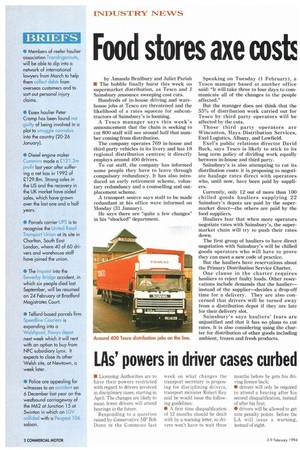Food stores axe cost
Page 4

If you've noticed an error in this article please click here to report it so we can fix it.
by Amanda Bradbury and Juliet Parish • The bubble finally burst this week on supermarket distribution, as Tesco and J Sainsbury announce sweeping cost cuts.
Hundreds of in-house driving and warehouse jobs at Tesco are threatened and the likelihood of a rates squeeze for subcontractors of Sainsbury's is looming.
A Tesco manager says this week's announcement that the chain is seeking to cut 800 staff will see around half that number coming from distribution.
The company operates 769 in-house and third party vehicles in its livery and has 18 regional distribution centres; it directly employs around 400 drivers.
To cut staff, the company has informed some people they have to leave through compulsory redundancy. It has also introduced an early retirement scheme, voluntary redundancy and a counselling and outplacement scheme.
A transport source says staff to be made redundant at his office were informed on Monday (31 January).
He says there are "quite a few changes" in his "shocked" department. Speaking on Tuesday (1 February), a Tesco manager based at another office said: "It will take three to four days to communicate all of the changes to the people affected."
But the manager does not think that the 55% of distribution work carried out for Tesco by third party operators will be affected by the cuts.
Those third party operators are Wincanton, Hays Distribution Services, Exel Logistics, Albany, and Lowfield.
Exel's public relations director David Buck, says Tesco is likely to stick to its long term policy of dividing work equally between in-house and third party.
Sainsbury's is also attempting to cut its distribution costs: it is proposing to negotiate haulage rates direct with operators who, until now, have been paid by suppliers.
Currently, only 12 out of more than 100 chilled goods hauliers supplying 22 Sainsbury's depots are paid by the supermarket direct—the others are paid by the food suppliers.
Hauliers fear that when more operators negotiate rates with Sainsbury's, the supermarket chain will try to push their rates down.
The first group of hauliers to have direct negotiation with Sainsbury's will be chilled goods operators who will have to prove they can meet a new code of practice.
But the hauliers have reservations about the Primary Distribution Service Charter.
One clause in the charter requires hauliers to reject faulty loads. Other reservations include demands that the haulier— instead of the supplier—decides a drop-off time for a delivery. They are also concerned that drivers will be turned away from a distribution depot if they are late for their delivery slot.
Sainsbury's says hauliers' fears are unjustified and that it has no plans to cut rates. It is also considering using the charter for distribution of other goods including ambient, frozen and fresh products.




















































































